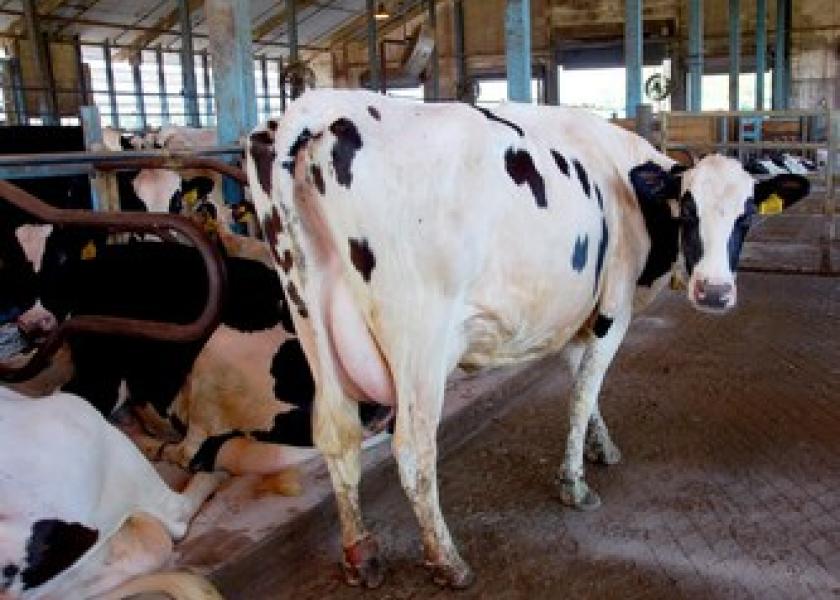Activity Monitoring for Reproduction

The use of activity monitors to predict ovulation and get cows pregnant.
By: Andrew Sandeen, Extension Educator, Penn State Extension
Synchronization protocols have become a great tool for many breeding programs, but most would probably abandon them in a heartbeat if there was another effective way to consistently predict ovulation and pinpoint the perfect time to breed cows. Activity monitors may provide a solution.
There is no silver bullet. It is generally agreed that getting dairy cows bred back after calving is an economically important factor in dairy management, but there is no perfect approach that addresses all of the challenges. Synchronization protocols have become a great tool for many breeding programs, but most would probably abandon them in a heartbeat if there was another effective way to consistently predict ovulation and pinpoint the perfect time to breed cows.
Though the use of a synchronization program is a fairly reliable option that usually helps maintain acceptable pregnancy rates and deal with cows that aren’t cycling normally, there are some inherent issues. There are costs associated with each injection: the cost of the drug, the cost of labor, and a likely cost to the cow herself. Though timed breeding programs, such as Ovsynch, allow a producer to breed cows at a precise time, the necessity for handling cows and strictly adhering to the schedule can be a hassle. Also, after getting maybe a third of the enrolled cows pregnant, there are still the remaining two-thirds that are not pregnant and keep progressing later and later into their lactation. Figuring out how best to diagnose pregnancy and re-breed open cows in a timely manner is tricky.
In many current-day management settings with high-producing cows, heat detection is a problem. Some facilities inhibit heat expression, some cows won’t show a good heat in any setting, and finding personnel who have the time to watch for heats isn’t easy. But we’ve known for a long time that accurately detecting the onset of estrus gives us a pretty accurate idea of when a cow will ovulate, and recommendations for when to breed a cow have stemmed from that understanding.
Increased activity is one of several secondary signs that correlate with a cow being in heat, and tools such as pedometers have been used to capture this activity for decades. More recently, activity monitors (accelerometers) have become increasingly popular, as they provide a better, more thorough measurement of all cow movement (more than just the number of steps that a pedometer measures) and alert you when there is an increase above the normal, baseline activity. Activity monitors are being used in dairy herds to assist with heat detection and aid breeders in determining when a cow is or has been in heat, and can even help to pinpoint the ideal time to breed a particular cow.
In a recent study, researchers found that activity monitors captured increased activity in about 70% of cows that had been pre-synchronized with two prostaglandin injections two weeks apart (Fricke et al., 2014b), which was an improvement on what could be expected using tail chalk, though it still failed to capture the remaining 30% of the herd.
A lingering question has been about when exactly to breed cows if you’re using activity monitors to detect estrus activity, since the monitors are only capturing a secondary sign of estrus. The answer is becoming clearer through research such as that recently reported by Stevenson et al. (2014). They found the average time to ovulation after a cow’s first standing event (the primary sign of estrus) compared to the time to ovulation after the onset of increased activity (a secondary sign of estrus) differed by less than two hours. On average, increased activity started at 24.6 hours before ovulation, and the first standing event took place at 26.4 hours.
The timing of ovulation is predictable after the activity threshold is reached, which is good news for those wanting to rely on activity monitors for detecting heats. Using the AM-PM rule, or some similar plan where breeding takes place about 9 to 12 hours after the onset of estrus activity, is still a valid strategy with an activity monitoring system.
The bad news is research is showing that overall conception rates are better on a timed AI program than when breeding based on activity monitor data. In this same research paper (Stevenson et al., 2014), conception rates were reported to be higher with timed AI than with the use of activity monitors, particularly in older cows.
There seems to be a trade-off when comparing a timed AI program to an activity monitoring program. Conception rates are often higher when cows are bred using timed AI, but cows are often bred and re-bred in a more timely manner when using activity monitors. In the end, the two breeding strategies often result in a similar impact on getting cows pregnant over the long run.
It is impossible to make blanket recommendations, because there are so many variables that change from herd to herd. What works in one herd might fail in another, and vice versa. Feeding programs, production levels, facility design, herd health, and many other factors all combine to make each dairy unique. However, research results seem to suggest that a combination of reproductive management approaches may be appropriate. The key is to figure out what approach(es) will work best with your unique herd dynamics.







